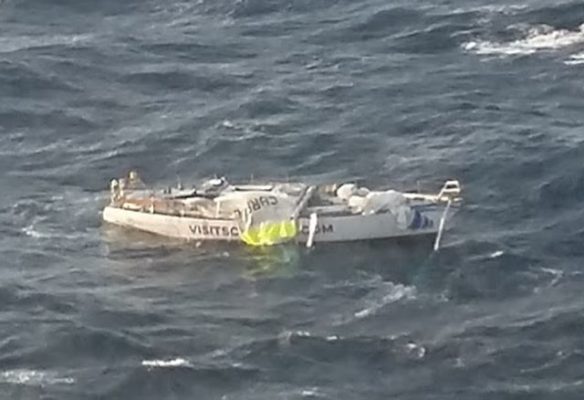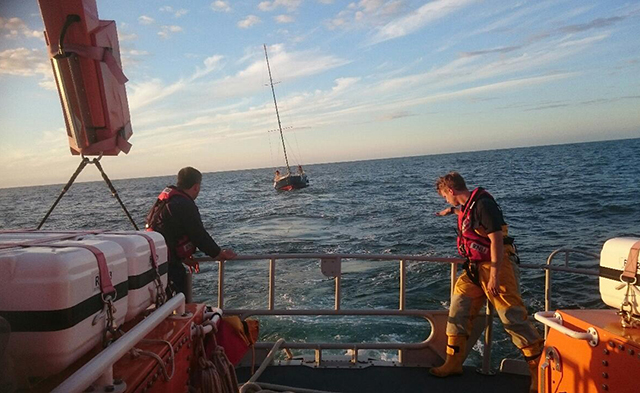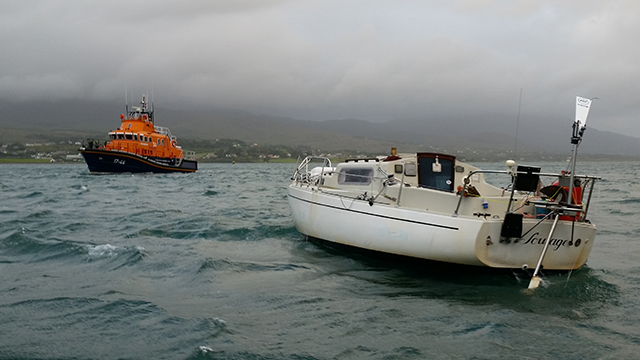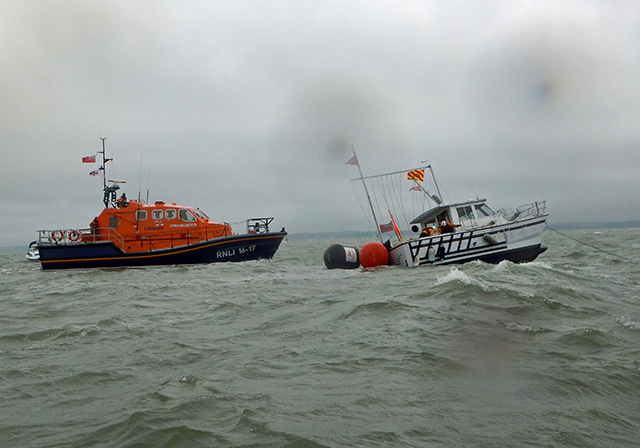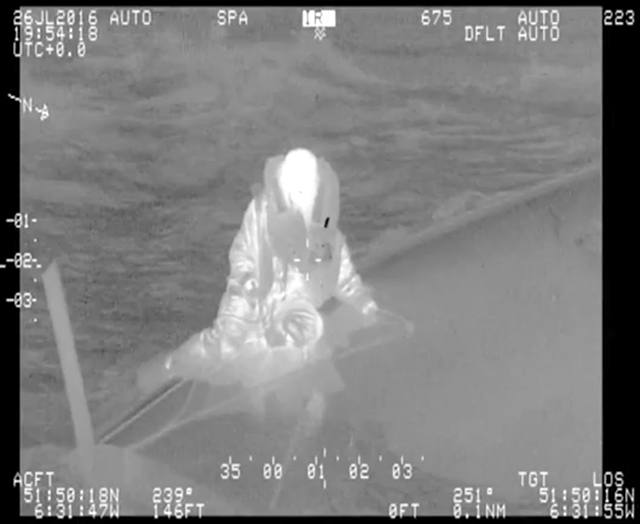Thirteen British crew and one US national were rescued after their 60ft yacht, the Clyde Challenger, dismasted due to bad weather, in the Atlantic Ocean.
The yacht crew sent an emergency beacon alert, which was picked up by the UK Coastguard at 8pm on Thursday evening.
All are now safe and well, having been rescued by a sea boat off of HMS Dragon on Saturday afternoon. The vessel was about 400 nautical miles west-south-west of Cape Finisterre when it suffered significant damage following days of strong winds and heavy seas.
‘We got hit with a rogue wave coming in the opposite direction,’ said the yacht’s skipper, 66-year-old Roy Graham, from Prestwick.
‘It hit us and knocked us over and dragged the crosstrees into the water, which dragged the mast into the water and snapped it at deck level.
‘There were maybe a few doubts in my mind but when I knew HMS Dragon was coming for us, I knew it was going to be a positive outcome. We are really pleased the Navy took up the challenge to come and rescue us.’

The UK Coastguard’s National Maritime Operations Centre co-ordinated the long-range search and rescue mission.
The Coastguard used satellite communications to request vessels able to assist the yacht to contact UK Coastguard and several responded with offers of help. The first merchant vessel on scene was the Industrial Challenger on the evening of Thursday 9 February.
It established contact with the Clyde Challenger and communicated with UK Coastguard about the issues with the vessel and the wellbeing of the crew.
A C130 Hercules aircraft from 47 Squadron RAF Brize Norton arrived on scene at 8am on Friday 10 February and immediately located the Clyde Challenger.
It provided on-scene communications to all of the vessels, aircraft and operations rooms involved in the mission. The Hercules was soon joined by the bulk carrier MV Cape Breeze.
Due to the storm-force conditions on scene the master of the bulk carrier deemed it too dangerous to close on the stricken yacht to facilitate a rescue.
The merchant vessels CPO Finland and Sti Dama arrived on the afternoon of Friday 10 February at which time the Hercules was replaced by a US Air Force KC 135 Tanker from 100th air refuelling wing based at RAF Mildenhall.

With weather on scene still precluding rescue efforts the MV Cape Breeze and Sti Dama were released. The CPO Finland remained on scene and attempted – without success – to rescue the crew three times.
Following liaison with UK Coastguard, on the evening of Friday 10 February, the Royal Navy’s Type 45 Destroyer HMS Dragon began making its way towards the Clyde Challenger’s position 500 nautical miles away.
Prior to the arrival of HMS Dragon the US Air Force 352nd Special Operations Group V22 Ospreys based out of RAF Mildenhall were cued up to attempt a long-range option but due to the weather on scene this option was not viable.
On the morning of Saturday 11 February the first of two US Navy patrol aircraft out of US Naval Air Station Sigonella (Sicily), replaced the Tanker aircraft as on-scene communications co-ordinator. The merchant vessel Antimilos also arrived on scene.
After sprinting at 30 knots through turbulent seas for 20 hours, the Royal Navy T45 Destroyer HMS Dragon arrived on scene on Saturday 11 February at 2.30pm and began the rescue of the 14 sailors using their two Pacific 24ft sea boats.
‘When we arrived on scene it was clear the yacht had lost its mast and looked in a pretty desperate state after nearly 48 hours drifting in the challenging conditions,’ said 29-year-old Petty Officer Max Grosse from Northwood, Greater London, who is the Chief Bosun’s Mate on board HMS Dragon.
‘We were however hugely relieved to see all 14 crew alive and well. Despite racing through the night we only had three hours of daylight remaining in which to safely remove the crew. HMS Dragon is fitted with two large sea boats capable of carrying six passengers each.
‘We were able to use both boats to transfer the crew as quickly as possible. The prevailing weather conditions and notorious Atlantic swell made it enormously challenging though and really tested the skills of my experienced sea boat coxswains.’
All crew had been rescued by 4.50pm. Once safely on board HMS Dragon the relieved crew were given medical attention, hot food and the opportunity to call loved ones at home.

The crew of the Clyde Challenger with members of HMS Dragon’s ship’s company who were involved in the rescue
Captain Craig Wood, HMS Dragon’s Commanding Officer said: ‘Within minutes of receiving the call we had altered course and were proceeding at maximum speed to intercept the Clyde Challenger.
‘At 500 nautical miles from our position she was a fair distance away and so it took an uncomfortable 20 hours to reach her in the rough seas but I am delighted HMS Dragon was able to provide vital assistance on this occasion and am rightly proud of the efforts of my sailors in rising to this challenge.
‘It is down to the capability of our ship and the skill of the men and women on board that we could accomplish this rescue in extremely difficult conditions.’
Other vessels that responded but did not participate in the search and rescue mission were the: Marco Polo, Afric Star, Ugale, and a Portuguese warship.
HM Coastguard would like to thank all those that took part in providing a successful outcome to this complex long range search and rescue mission.

Skipper uses the engine to maintain the best stability possible to facilitate as safe a transfer as they can
The racing yacht had left the Azores on 5 February 2017 and was bound for the UK when the drama occurred.
In a statement, Clyde Challenger shore team said: ‘The skipper, crew and shore team behind Clyde Challenger wish to express their thanks for all the messages of support we have received following the successful transfer of the crew and scuttling (sinking) of the yacht to ensure she was not a navigational hazard for other mariners.
‘We have now been able to speak directly with the skipper and gather more details of the events, summarised here:
- On Thursday evening, 9 February the yacht was hit by a large rogue wave during passage to the UK. She was sailing well at the time with a fully reefed mainsail.
- The impact of the wave knocked the yacht on her side. She recovered within a few seconds, however the mast had been severed at deck level. In addition the instrument pole at the stern of the yacht was also severed and a number of safety related items and communication systems were lost.
- The team quickly ascertained that all crew were accounted for and did not need any urgent medical attention.
- The crew then executed the appropriate procedures to alert other vessels in the area of their issue and triggered their long range satellite emergency beacon.
- A nearby cargo vessel was able to offer shelter until the damage on the yacht could be made safe. As the vessel hull was secure and capable of supporting the crew the decision was taken not to undertake an immediate transfer but to investigate all options. There was no damage to the rudder as initially suspected.
- The UK Coastguard rescue co-ordination team then worked hard with multiple agencies to maintain safety cover on site and communication with the vessel while crew transfer options were finalised.
- On Saturday 11 February, late afternoon, the crew of HMS Dragon successfully transferred the crew of Clyde Challenger to the safety of their vessel where they received a medical check up before being able to call family.
- Due to the severity of the damage to the yacht, the loss of equipment and the forecast weather the skipper was left with no option but to scuttle the yacht to ensure she did not represent a hazard to navigation.
‘The crew are now under the care of the Royal Navy and in good hands. They will have had a frightening experience when the yacht was knocked over however we are proud of the way in which the crew training and procedures were executed to maintain the vessel as a suitable shelter while transfer was arranged.
‘HMS Dragon, subject to operational reasons is due to disembark the crew mid week. Once we have confirmation of where and when they dock (which may change) we will work with each crew member to get them back home.’
LE James Joyce patrol vessel rescues sailor from sinking yacht
Offshore partrol vessel LÉ James Joyce rescued an Irish yachtsman from a sinking boat in difficult sea conditions, off the…
Seven crew rescued as cargo ship sinks off Ramsgate
The UK Coastguard co-ordinated an extensive search and rescue effort after a 90m cargo ship sank off the Kent coast,…
NZ Coastguard to rescue Vendée Globe skipper Thomas Ruyant
It is not too soon, as the situation has grown worse with the Vendée Globe boat sinking her bow down…
Vendée Globe skipper Kito de Pavant successfully rescued
After taking on water following a collision with an unidentified floating object in the South Indian Ocean, Vendée Globe's Kito…
Twelve rescued from dismasted yacht
Gosport & Fareham Inshore Rescue Service rescuers came to the aid of a stricken 40-foot yacht on Saturday, 1 October,…
Lone yachtsman sparks 14-hour rescue mission
The single-handed sailor had taken on quite a lot of water in bad weather through the night and his yacht's…
Storm-struck solo sailor thanks RNLI rescuers for saving his life
Castletownbere lifeboat volunteers spent 12 hours battling storm-force conditions to rescue a single-handed yachtsman 45 miles south of Mizen head…
Dismasted yacht rescued of Norfolk coast
A dismasted yacht was rescued by the independent Caister Lifeboat charity service off the coast of Norfolk.
Seven rescued from sinking catamaran in the Solent
Seven people were 'hurriedly evacuated' from a sinking catamaran - the Island Sailing Club’s J/111 class World Championships committee boat…
Lone yachtsman rescued from upturned vessel
A single-handed sailor was discovered sitting on his yacht's upturned hull, 20 miles off the Co Wexford coast, Ireland.




